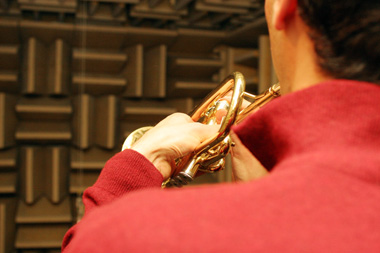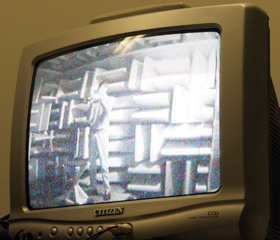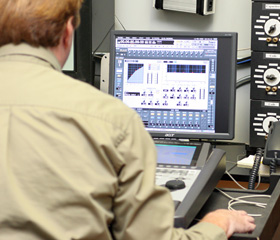![[SoundStage!]](../sslogo3.gif) The Traveler The TravelerBack Issue Article |
||
January 2007 Recording in an Anechoic Chamber
This year's trip wasn't in the summer, or even in the early fall when it's still nice outside. That's when I usually visit Axiom because it's the best time to see the Muskoka region (or most regions in Canada that don't involve skiing, tobogganing or ice fishing). Instead, it was in November, when, in Canada, it's cold, rainy and there's a good chance it will snow. It was only at this time, though, when a couple of our contributors from the United States could come up -- Home Theater & Sound writer Randall Smith and SoundStage! writer S.Andrea Sundaram -- and join fellow SoundStage! scribe Phillip Beaudette and myself for a tour of Axiom's facilities. The experiment, however, started late on the night of our arrival. It was too late to go to the factory -- that would wait 'til the next day -- so the group was kicking around the Colquhoun home listening to music through a set of -- what else? -- Axiom Audio speakers. The music was playing non-stop, with people picking favorites, when, at one point, Ian announced that he was going to put on a rather interesting recording of a guitar-playing female vocalist. There was a definite Jewel-like vibe to the music, and all the writers agreed that she was very good. So, too, was the recording -- very dynamic and lifelike, unlike most of the heavily compressed commercial releases that we're used to hearing. Then Ian surprised us by announcing that the girl actually lived down the road from him and that he had made the recording at his factory in the anechoic chamber! The writers looked a little perplexed, but I knew what Ian was up to, because he'd mentioned doing such a thing some time ago when he and I were discussing just how bad some commercial recordings sound. In fact, on my visit in 2005, Ian stated that he felt one of the weakest links in the whole chain wasn't the system itself but rather the recordings. After all, digital front-ends are very, very good these days. Exceptional amplifiers with almost limitless power are commonplace now. And there are quite a few speakers on the market that can play to lifelike levels with very low distortion, including Colquhoun's own M80 v2. So the recording end of things is something Ian that wanted to get to the bottom of. Part of that exploration involved seeing what impact the room in which music is recorded has when you play back that music in your own room, something that Ian refers to as "cascading rooms." Cascading is defined as "something occurring in a series." So, when music is recorded in a room, that room's sound is captured. However, when you play back that music, you have the sound of that initial room and your own room too. Hence, the "cascading" of rooms. Right now, Ian is trying to take that first room out of the chain. To do this, he employed what few recording studios have, but something some speaker companies have -- a full-size anechoic chamber. An anechoic chamber is an echo-free environment, the closest thing indoors to being in free-space outdoors. Essentially, no room. So, to make his recordings, Ian simply swaps out his measurement microphone for a microphone more suitable for music recording. Then the musician goes into the chamber, and from outside Ian captures the music on his recording console, which is placed alongside his speaker-measuring equipment. In a nutshell, that's how the recording of the "girl from down the street with the guitar" came to be. As the writers heard Ian explain things, I could tell they were quite interested. But then Ian mentioned he'd like to try to record other instruments, and we all agreed that this would be a good idea. Then S. Andrea Sundaram surprised us all when he piped up and told us he could play the trombone. We were impressed with that, but not nearly as much as when he told us he could sing -- opera! Ian looked at him for a moment, not expecting such a reply, and then said, "OK." Fast-forward to the next day. We're at Axiom headquarters. Ian's wife Amie is as resourceful and quick-thinking as he, and she popped into our meeting to let us know that she checked and the local music store (local, but 20 miles away, mind you; this is what happens when you're nestled in a resort area) doesn't have a trombone, but they do have a trumpet. "Can you play it?" I asked S. Andrea. "I can try," he said. "That's the SoundStage! spirit," I replied. Off Amie went to rent a trumpet. After lunch, we convened in the anechoic chamber. S. Andrea had his trumpet in hand and Ian was at his console. When we were ready to record, S. Andrea went into the chamber and Ian adjusted the microphone height as if he were measuring a speaker. Simple. S. Andrea played and Ian recorded.
To make a long story short, S. Andrea played the trumpet and sang opera, but he wasn't happy with his performance. We didn't care, though; he did better than any of us could. As well, we reminded him that this was an experiment, not a commercial release, so not to sweat it. With the recording complete, we next convened in Axiom's listening room where Ian played back the recordings at lifelike levels through a pair of M80 v2 speakers (speaker designers often have their favorite speaker; the M80 v2 is Ian's). The result was interesting, and not necessarily what you might expect. Some may think that a recording made in an anechoic chamber would be extremely dry. After all, there are absolutely no reflections in a chamber, so things like warmth and reverb get lost. Furthermore, the way Ian recorded it, there's no processing whatsoever -- just the microphone feed into the console. And, frankly, it was a tad dry, but in an average listening room that has its own reflective and absorptive qualities, along with its own sound that comes with these things, you do get some of that room sound back, so the recording certainly wasn't sterile at all. Furthermore, there was a real-ness and accuracy that don't exist in a lot of commercial recordings. After all was said and done, I thought to myself, Maybe there's something to it. Something to it doesn't necessarily mean that we need to throw musicians and orchestras in anechoic chambers and record that way, but it does mean that there's a whole lot more to experiment with on the front end of the playback chain to improve things downstream. And this "cascading rooms" notion is an interesting thing to think about when you're setting up your own system. How much of the recording's room do you want to hear? And how much should your own room alter the sound, putting its sonic signature on the recording? And what about things like room correction? How does that fit in? Or does it? As well, this little experiment doesn't mean that Axiom is getting into the recording business. But it does show that there's a whole lot more that can be done to improve the home-audio experience, and with companies like Axiom Audio, which has owners who haven't lost their enthusiasm for music and are willing to experiment, improvements can still be made everywhere in the playback chain. I suspect that as Ian fiddles on the recording side he might find things that benefit the playback side too. That relentless pursuit for improvement is, of course, what high-end audio should be all about, and it's what's alive and well at Axiom Audio. ...Doug Schneider To learn more about Axiom Audio, visit their website at www.AxiomAudio.com. |
||
|
||
![[SoundStage!]](../sslogo3.gif) All Contents All ContentsCopyright © 2007 SoundStage! All Rights Reserved |
 Every year I take a trip up to
Axiom Audio's headquarters nestled in the resort area of Ontario called Muskoka, and each
time I have something new to report. This time, what I am writing about has nothing to do
with speakers or electronics or any other type of product that Axiom produces, which is
usually what I write about. Instead it's about an experiment in recording -- music
recording -- and it's the type of thing that can seemingly only come about at a speaker
company with an owner who's as passionate about exploring all aspects of the
sound-reproduction chain as he is about making speakers. Ian Colquhoun is just such a guy
-- some describe him as the "Canadian cowboy of speaker design," most likely
because of his ambitious, unstoppable nature, and his desire to try anything at least
once.
Every year I take a trip up to
Axiom Audio's headquarters nestled in the resort area of Ontario called Muskoka, and each
time I have something new to report. This time, what I am writing about has nothing to do
with speakers or electronics or any other type of product that Axiom produces, which is
usually what I write about. Instead it's about an experiment in recording -- music
recording -- and it's the type of thing that can seemingly only come about at a speaker
company with an owner who's as passionate about exploring all aspects of the
sound-reproduction chain as he is about making speakers. Ian Colquhoun is just such a guy
-- some describe him as the "Canadian cowboy of speaker design," most likely
because of his ambitious, unstoppable nature, and his desire to try anything at least
once.
